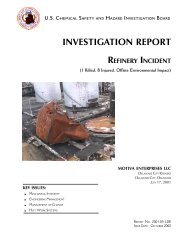CTA Report, Draft 1, ISP Review - US Chemical Safety and Hazard ...
CTA Report, Draft 1, ISP Review - US Chemical Safety and Hazard ...
CTA Report, Draft 1, ISP Review - US Chemical Safety and Hazard ...
You also want an ePaper? Increase the reach of your titles
YUMPU automatically turns print PDFs into web optimized ePapers that Google loves.
Table 4<br />
Comparison of Phenolic Resin MSDSs<br />
MSDS<br />
Fire <strong>and</strong> Explosion <strong>Hazard</strong> Warnings (a)<br />
Section Borden <strong>Chemical</strong> Seven Other Manufacturers<br />
<strong>Hazard</strong><br />
identification<br />
Firefighting<br />
measures<br />
Unusual fire<br />
<strong>and</strong> explosion<br />
hazards<br />
Explosive<br />
limits<br />
Stability <strong>and</strong><br />
reactivity<br />
Accidental<br />
release<br />
measures<br />
Special<br />
hazards<br />
CAUTION! Combustible dust when<br />
finely divided or suspended in air.<br />
Will burn, with a reference to NFPA<br />
654, if the material is reduced to or<br />
collected as a powder.<br />
One manufacturer warns: CAUTION!<br />
Powdered material may form explosive dust/air<br />
mixtures.<br />
Another states: Product may form explosive<br />
dust/air mixtures if high concentration of dust is<br />
suspended in air.<br />
Two manufacturers state: Plastic resin is not<br />
known or believed to be hazardous.<br />
Three manufacturers warn that dusts might<br />
form explosive mixtures in air <strong>and</strong> that ignition<br />
sources should be avoided.<br />
One manufacturer warns that electrostatic<br />
charges might build up during h<strong>and</strong>ling <strong>and</strong><br />
recommends grounding of equipment.<br />
Two manufacturers list no hazards.<br />
None listed. One manufacturer warns of the possibility of a<br />
dust explosion at the minimum explosive<br />
concentration of 0.025 ounce per cubic foot<br />
(oz/ft 3 .)<br />
Another warns that dust explosions may occur<br />
in air if certain conditions of concentration,<br />
humidity, <strong>and</strong> an ignition source are present.<br />
Not applicable. Two manufacturers state that the explosive<br />
limits are not determined.<br />
Another lists the resin as nonflammable.<br />
One manufacturer lists an LEL of 25 g/m 3 ,<br />
while three list 0.030 oz/ft 3 .<br />
In common with most organic<br />
materials, this product should be<br />
treated as a combustible dust in the<br />
finely divided <strong>and</strong> suspended state.<br />
Sweep (scoop) up <strong>and</strong> remove to a<br />
chemical disposal area. Prevent<br />
entry into natural bodies of water.<br />
One manufacturer warns: Avoid dust/air<br />
mixtures as this condition creates a<br />
flammability/explosion risk.<br />
Others list the material as stable.<br />
Six manufacturers advise avoiding generation<br />
of dust during cleanup of spills by using wet<br />
methods or vacuums with explosion-proof<br />
motors <strong>and</strong> eliminating sources of ignition.<br />
None listed. One manufacturer specifically advises against<br />
using compressed air for cleaning up<br />
combustible dust on floors, beams, or<br />
equipment.<br />
(a) Italicized words are quoted from the MSDSs.<br />
64









